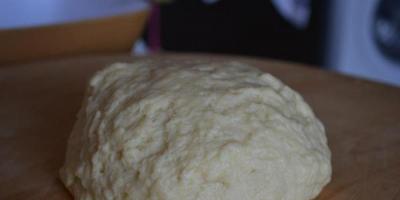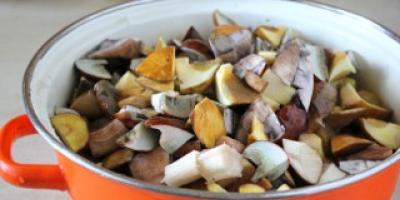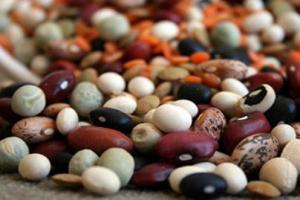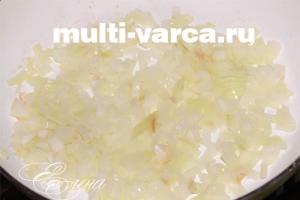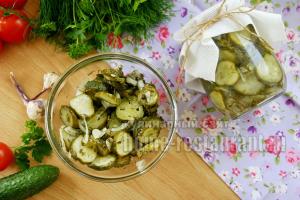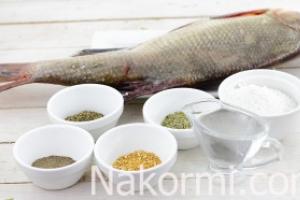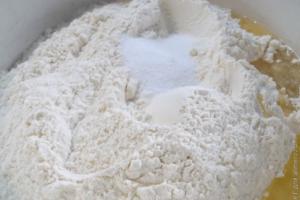There is still more than a month of fasting ahead, so you still have time to give up meat, fish and other things, if you haven’t already started. In fact, it is not as scary as it seems - there are many tasty and nutritious meals from products of plant origin.
If you know a little about veganism, you probably know some of the recipes. We decided to talk to the chefs of several restaurants specializing in Ukrainian, Georgian and Italian cuisines. We asked about traditions, recipes and secrets Lenten dishes.
Restaurant Chef" Chachapuri" Paata Kuchava
About traditional Lenten dishes Georgian cuisine
There are many lenten dishes in Georgian cuisine, but those made from beans and legumes are especially popular. Mushrooms and herbs are also staples for fasting. All this is very healthy, high in protein and vitamins. In general, greens work wonders; we eat them a lot. Also, for variety, you can cook something from potatoes or cereals.
Instead of meat, soybeans are often used in Georgia; it is very rich in proteins. But you can experiment.

For example, everyone is accustomed to the fact that dolma is prepared only with meat, but we stuff grape leaves with bulgur. To prepare another one popular dish For chakapuli, you can use mushrooms instead of meat - oyster mushrooms are better.
Tarragon must be added to chakapuli, because chakapuli without tarragon is already a different dish - chashushuli. But chashushuli is also usually prepared with meat, but if you cook it without meat, you get another dish - ajapsandali. To prepare it, you need to simmer asparagus, bell pepper, tomato, eggplant, potatoes and herbs with spices.

There are also a lot of meatless foods in Georgian cuisine. flour products– pies, where beans, mushrooms, and potatoes are used as filling. Even khinkali can be made with mushrooms or herbs. Of course, real khinkali are made with meat, but sometimes you can make fake ones. The dough there is always lean - made of flour and water.
Boiled beans recipe
There are many varieties of beans in Georgia, they are very popular. We eat more red, and in Ukraine - white. The most delicious are Batumi beans, but I have not seen this variety here. In general, you can cook from what you have, the main thing is the right seasonings.
The simplest thing you can do with beans is to simply cook them after soaking them. At the end of cooking, when the beans have become soft, add salt, pepper, herbs, a lot of herbs. Throw cilantro, celery and dill into the pan. But we don’t add parsley – we eat it separately, fresh.

If desired, you can add onions and garlic. Cook for just a couple more minutes. You can serve it hot or cold, but we prefer it hot.
Pkhali recipes
There are many walnut-based snacks in Georgia. For example, pkhali, it is prepared in the most different options: spinach, with leeks, from the leaves of a certain type of beet (red pkhali), or even from young nettles. The base is always the same – nut butter. The mixture should be homogeneous so that it can be spread on pita bread.
To prepare the paste, grind the walnuts with garlic and seasonings in any way, add just a little water. Spices include coriander, suneli hops, maybe a little adjika and garlic, salt and pepper. This paste can be used to stuff eggplants and zucchini, add to baked or fresh vegetables. Or still finish the pkhali.

For green pkhali, we take spinach, literally dip it in boiling water or keep it steamed so that it is just slightly cooked. Then we throw it in a colander, or simply squeeze it out of the water with our hands. Then mix the spinach with nut butter– the proportions depend on what flavor you want to make more pronounced – nuts or herbs. It is better to mix spinach pasta with a spoon rather than in a blender.
Borjomi mushroom recipe
The easiest way to cook mushrooms is to make them Borjomi style. We just take mushrooms and fry them in sunflower oil with Svanetian salt - this is a mixture of spices.
It doesn’t have to take up the entire kitchen and dirty all the dishes, but it turns out delicious. Regular champignons are suitable, you just need to rinse them well and fry them on both sides in a frying pan. The dish is ready in 7-8 minutes.

Lenten dessert recipes
Georgians are spoiled with Lenten desserts, because we have never developed a confectionery business. But on New Year There is a custom of giving out sweets to everyone, so I still had to learn how to cook them.
Another sweet that everyone knows is kozinak. Walnuts are traditionally used here, but you can use others if you wish. You just need to finely chop the nuts and mix with honey.
There is also a lot of pumpkin in Georgia, so you can make halva from it. True, our pumpkin is tastier, sweeter and not as watery as Ukrainian pumpkin. But local will work too, you just need to squeeze the juice better and add more honey.

For 400 grams of grated and squeezed pumpkin you need 100 grams of semolina, 100 grams of honey, 100 grams of any chopped nuts and 50 grams of raisins. In our country, hazelnuts or walnuts are more popular, but it will also be delicious with peanuts. First, we mix this pumpkin with semolina and fry it in a frying pan with oil (40 ml) for 5-7 minutes, add 100 ml of water and simmer a little.
Add the remaining ingredients when the mixture has cooled, because honey cannot be added to hot dishes. Then mix it all and put it in the refrigerator. We get a healthy dessert.
By the way, my mother deceived us when we were children, saying that it was orange halva, because for some reason all the children did not like pumpkin. When we first really prepared halva with orange zest, I was even surprised that it didn’t turn out the way we were used to. By the way, you can add the zest of one orange to the same recipe and you will get a completely different taste.
Sergey Matuzov, restaurant chef Bigoli
About the traditions of Lent in Italy

In my experience, finding something authentically Lenten in Italy is simply impossible. These cunning people simply do not fast. Their Quaresima ( Lent) is some kind of resort compared to our forty-day torment.
In Italy, you only need to give up meat as much as possible, and even then not on all days. That's why everyone is fasting italian recipes– these are rather variations on a theme. For example, residents of the northern regions can prepare pasta without eggs, but often flavor it with cheese (for example, peccorino is usually added to pici, and goat cheese is usually added to pasta alla norma with eggplant).

Lenten pasta recipe
In the original, puttanesca pasta is prepared with anchovies, but you can do without them. First you need to take pasta without eggs, or prepare it yourself from solid semolina flour and water. If you buy, most likely it will be pasta from the southern regions of Italy.
Next we need tomatoes, olives, onions, garlic. We use Ligurian or Taggi olives, but, of course, you can use others, even jarred ones. It is desirable that they have bones. But the tomatoes don’t matter what kind: fresh or canned in their own juice.

All this is lightly fried in a frying pan and stewed with tomatoes. Instead of broth, add a little water or vegetable broth to the mixture. In just a few minutes we cook the pasta and add it to the already prepared dressing - that’s all.
Dessert Recipes
I thought for a very long time about a dessert that would be both Italian and Lenten. I decided it was a sweet sorbet. Then I thought that sorbet still can’t be called a dessert, so I suggest just baking an apple - it’s easy.
You need to take an unsweetened apple, sprinkle it with sugar and put it in the oven for 15-20 minutes. Semerenko or some other late apples that are quite strong and green are best suited.

You can also make homemade granola: take any cereal, add pumpkin or sunflower seeds, flax seeds. Mix it all with honey and put it on parchment, then put it in the oven.
Petr Saman, chef of the restaurant "Khutorets na Dnipri"
About Lenten dishes in Ukrainian cuisine

In Ukrainian tradition, fasting is scheduled day by day. On some days you only need to eat vegetables, on others you can eat fish. Some days you go hungry and live only on water. Sometimes, thank God, you can have wine. But we definitely forget about meat and dairy all the time.
Zucchini recipes
All kinds of zucchini dishes are perfect for fasting. For example, you can simply fry them in vegetable oil, pre-salt, pepper and roll in flour. Before eating them, it is better to blot them with a napkin to remove excess oil.

You can cook with zucchini lean mayonnaise: brew the flour in water (just throw it into boiling water and cook), let it cool. At this time, take fresh lemon, mustard, sugar, salt, vegetable oil (one to four), beat it all and add it to the cooled flour mixture. Place in the refrigerator and the mayonnaise is ready.
You can also make caviar from zucchini. Bake vegetables in the oven for about half an hour at 180 degrees - zucchini, bell peppers, carrots, onions. In this case, it is better to simply wash the onions and carrots and wrap them in foil. Remove the eggplant and pepper after 20 minutes. Add herbs, garlic to the vegetables, you can add to taste hot pepper– chop all the ingredients finely (do not twist in a meat grinder) and mix. Let it cool and you are ready to eat. Serve with lean bread– There is a large selection in supermarkets.
Bean recipes
In almost any dish, meat can be replaced with beans. For example, in a roast. We just take the usual recipe and put boiled beans in it instead of meat.
During the Lenten period, borscht can be cooked with mushroom soup and beans.

You can also make a paste from beans: boil red and white beans, add carrots, onions, garlic and simmer everything together until tender (usually takes about two hours). Remove the vegetables and beans from the heat, add any nut you have at home, you can even pumpkin seeds– mix everything in a blender and cool. Then add herbs and garlic to taste.
Recipe for banosh with mushrooms
To cook this classic dish, corn grits needs to be cooked vegetable broth and put in the oven for 5-10 minutes. Fry white or any other mushrooms separately. Then add them to the cereal and keep in the oven for another 10-15 minutes.

By the way, the correct name for any lean porridge in the Ukrainian tradition is toukan, but we are used to calling this dish banosh.
Lenten dessert recipe
You can make apple roll with lean dough– from water, salt, sugar, flour and vegetable oil. It is important to stretch it with your hands and not roll it out with a rolling pin - then it becomes thinner.
For the filling we take apple, pear, dried fruits and nuts. All this needs to be crushed, mixed and caramelized a little in a frying pan with sugar.

Place the finished filling on the dough, wrap it, sprinkle powdered sugar, cinnamon, nuts and place in the oven for half an hour (170 degrees). After removing the roll from the oven, be sure to cover it with a towel and let it cool to room temperature - only then cut it.
Photo: Photo by Organic Ideas for Organic Peoples, Bigoli, Khutorets on the Dnieper
Georgian cuisine is ideal for Orthodox Lent. It is not surprising, because most of the residents of Georgia also observe it. And it’s as if they came up with pkhali, lobio and ajapsandal especially for fasting. But Lenten Georgian cuisine is not limited to these dishes. You can even prepare lean khachapuri. The basis of lean Georgian cuisine is beans. Also added to it are nuts, mushrooms and lots and lots of greens, especially cilantro. Don’t forget to stock up on a bag of khmeli-suneli - and you’ll be able to cook interesting Georgian dishes throughout Lent. And we will help with recipes:
Salad Broceuli
Photo: Restaurant "Kazbek"
- 5 g mint
- 10 g tarragon
- 5 g parsley
- 5 g dill
- 5 g cilantro
- 15 g tsitsmati (Georgian equivalent of watercress - editor's note)
- 20 g peeled cucumbers
- 5 g green onions
- 100 g pink tomatoes
- 15 g pomegranate
- 20 g narsharab sauce
- 2 g Svan salt
Step 1. Process the green leaves, rinse, dry and add chopped tomatoes into slices.
Step 2. Place on a plate, sprinkle with pomegranate, Svan salt and pour over pomegranate sauce narsharab.
Adjarian khachapuri with mushrooms

- 1 cup flour
- ½ glass of water
- 3 g salt
- Dry yeast
- 5 ml vegetable oil
For the filling:
- 150 g onion
- 1 kg oyster mushrooms
- 10 g garlic
- Salt and pepper
Step 1. Add salt and yeast to the water, mix, sift in the flour, then mix thoroughly again and add vegetable oil at the end.
Step 2: Cover the dough cling film and leave it to come up.
Step 3. When the dough has risen once, you need to mix it and leave for another 15 minutes.
Step 4. Take 200 g ready dough and roll it into a ball, then roll it out with your hands. The edges should be thinner, the middle thicker.
Step 5. For the filling, cut the mushrooms and onions, add chopped garlic and spices, fry in a frying pan.
Step 6. Then you need to put the filling on the dough and “close” the edges of the dough, forming the khachapuri in the shape of a “boat”.
Step 7. Bake in the oven at high temperature for 6 minutes.
Khachapuri-lobiani

Photo: City cafes “Khachapuri”
Recipe Dmitry Milyukov, chef of the city cafe "Khachapuri"
Dough (for 5 khachapuri)
- 500 g flour
- 300 ml water
- 5 g dry yeast
- Pinch of salt
- 350 g beans
- 40 ml vegetable oil
- 200 g onion
- 200 g red onion
- Salt and pepper
- Utskho-suneli
- A pinch of ground coriander
Step 1. Mix flour with salt and yeast.
Step 2. Make a funnel in the center, add water. Knead the dough until smooth, cover.
Step 3. Let the dough rise. Stir again.
Step 4. Boil the beans until tender, discard in a colander.
Step 5. Chop the onion and sauté in vegetable oil until tender. Mash the beans and add the sautéed onions.
Step 6. Mix everything thoroughly until smooth. Cool and weigh out 200 grams (the amount of filling for one pie).
Step 7. Roll out the dough, lay out the prepared minced meat, pinch the edges in a circle in the center. Roll out some khachapuri and make holes with a skewer.
Step 8. Place the khachapuri on a baking sheet and bake until done. At the highest temperature for 15-20 minutes.
Bell pepper rolls stuffed with walnuts

Recipe Rusiko Shamatava, chef of the John Jolie restaurant

Step 1. Bake whole bell peppers with stems in an oven preheated to 180 degrees for 15-20 minutes. Cool, remove skin, stems and seeds.
Step 2. Rub the nuts with red adjika. Finely chop 25 g of cilantro and mix with nuts, salt and suneli hops.
Step 3. Add cold boiled water, mix everything thoroughly until smooth.
Step 4. Chop the onion very finely and fry in heated vegetable oil until golden brown. Remove from stove, cool.
Step 5. Add fried onions to the main nut filling. Mix thoroughly until smooth and tasteful.
Step 6. Cut grilled peppers without skin and seeds lengthwise into plates 4-5 cm wide and 10-11 cm long.
Step 7. Place the prepared pepper slices face down on the board, place the filling (about 22 g) in the center and roll lengthwise into rolls (from the narrow edge to the wide one).
Step 8. Place 4 rolls on each plate. bell pepper(2 red and 2 yellow) with the filling facing up. Decorate the center of the dish with cilantro leaves, and place pomegranate seeds on the free space of the plate.
Chashushuli from wood mushrooms

Photo: Restaurant "Kazbek"

Step 1. Process the oyster mushrooms, rinse them from sand.
Step 2. Fry finely diced onion and garlic in a frying pan.
Add processed oyster mushrooms.
Step 3. Fry the oyster mushrooms for 5 minutes and add white wine, then simmer for another 15 minutes.
Step 4. Add spices and herbs.
Step 5: Sprinkle with pomegranate and tarragon leaves before serving.
Dessert Tatara

Photo: Restaurant "Kazbek"
- 50 g grape syrup "Isabella"
- 1 liter white grape juice
- 175 g corn flour
- 50 g sugar
Step 1. Grape juice bring to a boil, then simmer until reduced by half.
Step 2: Add grape syrup.
Step 3. Slowly, adding flour, knead into a single homogeneous mass.
Step 4. Moisten a baking sheet with high sides cold water and pour the resulting mass there.
Step 5. Without covering, let cool and leave for 12 hours.
Lenten cherry pie

- 200 g flour
- 55 g honey
- 180 g sugar
- 50 ml vegetable oil
- 50 g almond flour
- 10 g soda
- Lemon juice
- 200 g cherries
- 40 g walnuts
Step 1. Dough: add honey, sugar, vegetable oil, almond flour, quenched soda to the flour lemon juice, and mix.
Step 2. Add cherries (fresh or frozen) and chopped walnuts to the kneaded dough.
Step 3. Place in a baking dish and bake for 50-60 minutes at 160 degrees.
Step 4. When serving, you can pour cherry sauce over it.
No, friends, we are not turning into a culinary site. The thing is that, when talking about Georgia, it is simply impossible to ignore the topic of food or touch on it superficially: the food here is so amazing that it’s worth coming here just to eat.
This is another article about Georgian cuisine, this time - as many as 30 dishes that you must try. Read, take notes and be sure to come try.
1. Puri
It’s not for nothing that they say that bread is the head of everything. Georgian cuisine begins with bread; bread is special here and is one of the main components of the diet. Puri is the most recognizable pastry in Georgia due to its shape - this bread cannot be confused with anything else.

Georgians bake bread in traditional clay ovens called tone. The fire burns at the bottom of the oven and heats its walls, onto which the Georgian baker “slaps” the flatbreads so that they are attached and baked upright.
2. Khachapuri
Georgian cheese bread or flatbread with cheese is another important component of Georgian cuisine. There are several versions of preparation khachapuri, which depend on the region. You need to try everything:
Imereti - round with cheese inside.

Megrelian - similar to Imeretian, but contains cheese and butter not only inside, but also outside.

Adjarian – boat-shaped khachapuri containing cheese, egg and butter.

Khachapuri on a skewer - cheese and dough are wound on a spit and cooked on a barbecue.

3. Nazuki
is a Georgian spiced bread that you can’t try anywhere. It is also baked in tone, but is interesting because it has the aroma of cloves, cinnamon and contains raisins. This pastry is typical for the city of Surami. There are many small roadside bakeries where you can buy nazuki hot straight from the oven.

4. Chvishtari
Chvishtari is Georgian cornbread. They come from Svaneti. Inside there is chvishtari cheese, served with sauce.

5. Suluguni
Georgian cheese, similar in texture to mozzarella. It is salty, viscous, and separates into “strings.” It is eaten plain or added to various dishes(for example, khachapuri).

6. Nadugi
This is the original Georgian appetizer, consisting of fresh cottage cheese with gentle creamy taste, wrapped in thin suluguni cheese.

7. Jonjolie
A traditional Georgian appetizer, unprepossessing in appearance, but very interesting in taste. These are pickled flowers. A little reminiscent of sauerkraut and salted olives.

8. Salad
The word “salad” on the menu of Georgian cafes often refers to a salad made from cucumbers and tomatoes. Additional Ingredients and filling may vary depending on the establishment. The photo shows a salad of cucumbers and tomatoes with onions and walnut. It also turns out very tasty with Kakhetian butter.

9. Georgian chicken salad
Another salad that often appears on the menu of most establishments is listed as qatmis salati. It is a simple chicken salad with onions, mayonnaise and spices.

10. Olivier or Russian potato salad
Olivier is considered a traditional dish of Russian cuisine here. This salad is quite popular and is served almost everywhere. But this is not the Olivier we are quite familiar with. Here it is prepared without sausage. And it is often confused with vinaigrette - ask the waiter what exactly is called Olivier in the establishment.

11. Badrijani
One of the most favorite snacks among tourists is eggplant rolls. The filling can be very varied, but always contains cheese and walnuts.

12. Pkhali
Pkhali – original snack in the form of flatbreads, the main ingredient can be almost any vegetable or herb, the most popular being beets and spinach. Served as a side dish meat dishes, as an independent dish, as a snack.

13. Dolma
This is a snack in the form of a rice and meat mass wrapped in cabbage or grape leaf. In Georgia it is traditionally served with garlic sauce from matsoni. Strictly speaking, this dish armenian cuisine, but in Georgia they love dolma and know how to cook it.

14. Khinkali
This is boiled meat in dough, reminiscent of dumplings. You should eat exclusively with your hands, holding them by the tails. In each region they are prepared differently and with with different fillings. In Tbilisi, we recommend trying the city recipe with meat and herbs. If you are traveling along the Georgian military road, stop in the village of Pasanauri. It is considered the birthplace of khinkali and here they are excellent.

15. Chikhirtma
Unusual chicken soup, which includes meat, herbs, egg, flour and vinegar. If you're not used to it, it may seem a little sour due to the vinegar, but overall the taste of the broth is rich and harmonious. If you had too much wine yesterday, chikhirtma will be your salvation.

16. Mtsvadi
Served with tkemali plum sauce or tomato satsebeli. As a rule, the meat is prepared without any marinade at all, but generously flavored with onions and pomegranate seeds.

17. Fried potatoes
A classic side dish that can be ordered everywhere is - fried potatoes, which is served with tkemali sauce.

18. Lobio
A dish of beans with onions and herbs. Depending on the establishment, it may differ slightly in both composition and consistency. It is most often served in a small clay pot. Try drowning a hot pepper in a pot and eating lobio along with mchadi (corn cake).

19. Chashushuli
A traditional Georgian dish is veal stewed with onions and peppers.

20. Chakapuli
Again, meat stewed with herbs and spices. Lamb is used as meat, and sour plums, cilantro, tarragon, and white wine are used as additives.

21. Kharcho
Traditional Georgian first course with beef, can be served with or without rice. There are also vegetarian versions of kharcho with eggplant, zucchini, and walnuts. Be careful - kharcho is always a very spicy dish.

22. Trout in pomegranate sauce
Whole trout is fried until crispy and served in a sweet or salty pomegranate sauce.

23. Matsoni
This is Georgian yogurt. It has a pleasant subtle taste and is served at room temperature. Also widely used in sauces and dressings.

24. Churchkhela
This is a dessert in the form of a string of nuts in thick caramelized grape syrup. It is sold on every corner, but do not buy churchkhela on the street - there it has dried out and absorbed all the delights of road dust. Buy in stores. Correct churchkhela- not hard, but stretchy, like nougat.

25. Chiri
Chiri is dried persimmon. This delicacy can be found in the same shops where they sell churchkhela. Sliced persimmons are strung on threads and hung until completely dry for several weeks.

26. Borjomi
This is popular mineral water not only in Georgia, but also far beyond its borders, which is extracted from the source of the same name. You can buy it in any store and cafe, and also drink directly from the source if you find yourself in Borjomi.

27. Lemonade
If Georgians don't drink Borjomi, wine or beer, then they drink lemonade. There is many variations of lemonade, it comes in different tastes and colors.

28. Waters of Lagidze
This is sparkling water with syrups that awakens warm nostalgia in tourists. There are many flavors: cherry, cream, lemon, pear, tarragon, grape, vanilla and even chocolate.

29. Traditional wine
Namely, made in qvevri (large clay jugs buried in the ground) according to traditional recipe, as our ancestors did eight thousand years ago. You won’t taste this kind of wine anywhere else in the world, so take advantage of the moment and taste it Georgian wines and take it home.

30. Chacha
Traditional grape vodka, which is made from leftover wine materials. Try chacha if you like strong alcoholic drinks. The main thing is to calculate your strength and do not mix with other alcohol.

This list is far from complete; there is a lot more in Georgian cuisine delicious dishes. When you find yourself in Georgia, eat everything and more - it’s better to gain a couple of extra pounds than to regret the missed opportunity to experience one of the most amazing cuisines in the world.
Based on materials from Katherine Belarmino and Romeo Belarmino.
Lent has begun - a time of spiritual cleansing and abstinence, during which the consumption of certain foods is prohibited - we offer recipes for delicious Lenten dishes with photos and descriptions.
We present ten delicious Georgian dishes that will diversify everyday life fast days and will help you to endure the “hardships” of a long and strict fast with relative ease.
1. Lobio – Georgian beans in pots
"Lobio" - traditional dish Georgian cuisine, which means “beans” in Georgian. Many dishes are prepared from lobio in Georgia, seasoned with a variety of delicious spices for which Georgian cuisine is famous.
We offer one of delicious recipes, which is easy to prepare. To prepare classic lobio you will need: 500 grams of red beans; two heads onions; four cloves of garlic; two dinner spoons of tkemali or tomato; 50 grams of vegetable oil; fresh cilantro; half a teaspoon of dry Georgian seasonings - utskho suneli, saffron, ground cilantro seeds (coriander) and mint; Svanetian salt and pepper to taste.

Lobio
Cooking method: Cover the beans with cold water and cook for 2.5-3 hours, stirring occasionally, until the beans are soft. In order for the beans to cook quickly, they should first be soaked in cold water for several hours. Chop the onion and fry it in vegetable oil, then add finely chopped garlic, dry spices, tomato or tkemali and simmer over low heat for a couple of minutes.
Then add the prepared beans and a little water in which they were boiled to this mass, and, stirring, lightly mash them with a wooden spoon.
Finish with fresh cilantro, salt and pepper to taste. Lunch is ready!
It is advisable to serve lobio at clay pots, lightly sprinkling fresh herbs on top.
2. Eggplant rolls with walnuts
To prepare this dish you will need: 500 grams of eggplant; 150 grams walnuts; one small head of garlic; one bunch of cilantro; two tablespoons of vinegar; half a teaspoon of Georgian seasonings - utskho suneli, saffron, coriander; vegetable oil for frying; salt and pepper to taste.

Eggplant rolls
Cooking method: Wash the eggplants, dry them and cut them into long thin strips. Add a little salt to each strip, place in a bowl and leave for an hour. Then squeeze and fry the eggplants in vegetable oil on both sides. Grind the nuts and garlic in a blender, add seasonings, vinegar and mix thoroughly until smooth. Then add chopped herbs, salt and pepper. If desired, you can add pomegranate seeds. Spread the fried eggplant strips with the resulting nut paste and roll up.
3. Mchadi
Mchadi are Georgian Lenten flatbreads made from corn flour that can be eaten instead of bread.

Mchadi
Cooking method: pour 500 grams of sifted corn flour into a bowl and add hot water while kneading. The dough should be wet, but not stick to your hand. It should be noted that mchadi dough likes to be kneaded for a long time and thoroughly. Ready dough you need to put it aside and let it sit for at least a couple of hours.
Heat a frying pan and pour some sunflower oil. Then, with wet hands, make oval-shaped pies out of the dough and place on hot frying pan. When one side is browned, turn them over and cook the other side. Ruddy pies should be served hot. The secret of successful mchadi lies in high-quality finely ground corn flour.
4. Spinach pkhali
To prepare this dish you will need: one kilogram of spinach; 150 grams of walnuts; one small head of garlic; one bunch of cilantro; two tablespoons of vinegar; half a teaspoon of Georgian seasonings - utskho suneli, saffron, coriander; salt and pepper to taste.

Pkhali
Cooking method: Sort the spinach and rinse. Cook in boiled water for seven to ten minutes until the leaves are soft. Then place in a colander and let drain thoroughly. Grind the nuts and garlic in a blender, add seasonings, vinegar and mix thoroughly until smooth. Then add chopped herbs, salt and pepper. Mix the resulting mass with pre-squeezed herbs, and the dish is ready.
5. Gomi – Georgian porridge
Gomi is a thick porridge made from gergil (crushed cornmeal) with the addition of finely ground cornmeal.

Gomi
Cooking method: A kilogram of gergili should be poured into a cast iron pot and rinsed thoroughly under running water. You need to wash it for a long time, washing out the black particles of the grains, until the grain becomes snow-white. Then fill the cereal with cold water 1:3 and place on high heat. When the mixture boils, stir with a long wooden spatula and reduce the heat. Cover the cast iron tightly and cook for about forty minutes, stirring thoroughly with a spatula from time to time.
When the porridge is almost ready, you need to take a glass of corn flour and pour it into the porridge little by little, stirring well so that the mass is homogeneous and smooth. Then cover and simmer over low heat for about ten minutes. You can add a little salt. Then turn it off and serve in portions on plates.
6. Cauliflower in a bage
Bazhe is a walnut-based sauce that goes well with chicken, vegetables and fish and adds an extraordinary taste to any dish. To prepare you will need: a medium head of cauliflower; 100-150 grams of walnuts; two cloves of garlic, half a tablespoon of vinegar; half a teaspoon of dry seasonings - utskho suneli, saffron, coriander; salt and ground red pepper to taste; warm water by eye.

Cauliflower in the bag
Cooking method: Wash the head of cauliflower in cool water and separate it into medium-sized inflorescences. Pour water into a saucepan, add one and a half teaspoons of salt and put on fire. Bring to a boil, reduce heat, add cabbage and cook for 10-15 minutes. Then place the cabbage in a colander and rinse with cold water. Place all ingredients for the sauce in a blender and blend. Add water to the resulting mixture little by little so that the sauce does not turn out too liquid. Then put the cabbage in a container and pour the sauce over it.
7. Mushrooms baked in ketsi
Champignons baked in ketsi (clay frying pan) is a traditional Georgian dish. In ketsi, dishes are prepared with virtually no fat, thereby preserving the unique taste and aroma of the products, their beneficial properties. To prepare this dish you will need: one 200 gram jar of champignons; vegetable oil; salt and pepper to taste.

Mushrooms in ketsi
Cooking method: Separate the mushroom stems from the caps, pour boiling water over them and place in a colander. Then place the caps in ketsi in one layer, add salt and pepper, and bake in the oven for 15 minutes.
8. White cabbage with walnuts
To prepare this dish you will need: white cabbage medium size; 150 grams of walnuts; one small head of garlic; one bunch of cilantro; two tablespoons of vinegar; half a teaspoon of Georgian seasonings - utskho suneli, saffron, coriander; salt and pepper to taste.
Cooking method: Wash the cabbage head and cut out the core. Place in a pan of boiling water and cook until soft, but not mushy. Then drain in a colander and divide it into leaves. From each leaf you need to cut off a thick vein in the middle.
Grind the nuts and garlic in a blender, add seasonings, vinegar and mix thoroughly until smooth. Then add chopped herbs, salt and pepper. The resulting mass should be spread on each cabbage leaf and wrap it in an envelope or tube, this is optional.
9. Lobiani – khachapuri or flatbread with beans
These delicious flatbreads stuffed with beans, along with khachapuri (flatbread with cheese), are a decoration for any feast, but, according to tradition, they are necessarily baked and eaten in Georgia on December 17 - the day of St. Barbara, in Georgian “Barbaroba”. According to legend, the Saint fed Lobiani the hungry.
To prepare this dish you will need: two glasses of warm water; 1 packet of dry yeast; three glasses of flour; half a teaspoon of salt and sugar, three to four tablespoons of vegetable oil; 400 grams of beans; three cloves of garlic, spices, one bunch of cilantro.

Lobiani
Cooking method: In a deep bowl, mix warm water, salt, sugar, yeast and flour. The dough should become elastic, but not too stiff. If necessary, add more flour. Leave in a warm place for the dough to rise.
While the dough arrives using a meat grinder or blender, we transform the pre-cooked beans into a puree, add garlic, spices, oil, cilantro and salt. The dough is divided into 5 equal parts, each part is rolled into a round cake. In the middle of each flatbread we place a filling equal in size to a lump of dough, and we gather the edges of the flatbread in the center and roll out the flatbread again. The thickness of the lobiani should not exceed one centimeter. The top layer of dough in the middle of each lobiani is pierced several times with a fork.
Fry the tortillas in a dry frying pan over medium heat, first on one side, and then carefully turn over and fry on the other. Or bake in a preheated oven.
10. Fish in kindzmari sauce
During Lent, eating fish is allowed on the feasts of the Annunciation of the Blessed Virgin Mary and Palm Sunday, so we offer you a delicious traditional recipe.
To prepare this delicious dish you will need: one kilogram of catfish (or any other fish, if desired); 100 grams of wine (white) vinegar; 500 grams of broth, one bunch of fresh cilantro; six pieces of bay leaf; 10 sweet peas; salt to taste.

Fish in kindzmari sauce
Cooking method:
We clean the fish from giblets and fins and cut it into pieces. Boil water in a saucepan, add salt, bay leaf and allspice. Let it simmer for 3-4 minutes and then lower the fish and cook until done, no more than 5 minutes. We take out the finished fish with a slotted spoon and transfer it to a bowl where it will marinate in the sauce. Then, strain the broth, add vinegar, cilantro, pre-chopped, as well as bay leaf and allspice. Pour the prepared sauce over the fish, cover the dish and let it sit for several hours so that the fish is thoroughly soaked.
Bon appetit and good mood!
